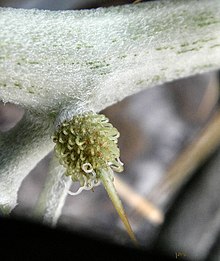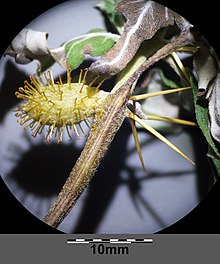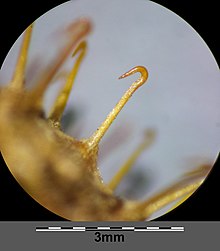Thorny pointed burdock
| Thorny pointed burdock | ||||||||||||
|---|---|---|---|---|---|---|---|---|---|---|---|---|

Thorny pointed burdock ( Xanthium spinosum ) |
||||||||||||
| Systematics | ||||||||||||
|
||||||||||||
| Scientific name | ||||||||||||
| Xanthium spinosum | ||||||||||||
| L. |
The thorny pointed burdock ( Xanthium spinosum ) is a type of plant from the genus of pointed burdock ( Xanthium ) in the subfamily of the Asteroideae within the family of the daisy family (Asteraceae).
description


Vegetative characteristics
The thorny pointed burdock is an annual herbaceous plant and reaches heights of 20 to 80 centimeters. It has a richly branched, spindle-shaped root. The upright and mostly sparsely branched stem from the bottom . The stem is round, scattered and hairy and whitish with green vertical stripes. On the stem on both sides of the base of the petiole there is a three-part, straw-colored or slightly reddish thorn with a short base and usually three spreading, 10 to 25 millimeter long thorns.
The alternate leaves are arranged in a petiole and a leaf blade. The upper side of the leaf is dark green and the underside of the leaf is covered with gray tomentose hair due to short, very dense trichomes . The leaf blade is rhombic in outline and usually three-lobed with an elongated central lobe and obliquely forward lateral lobes. The middle lobe is pointed in front and usually has one or two pairs of coarse posterior teeth. The base of the leaf is narrowed in the shape of a wedge into the petiole and sometimes also has a tooth on each side. The uppermost leaves are lanceolate and have entire margins or each have a tooth on both sides.
Generative characteristics
The flowering period extends from August to October. The thorny pointed burdock is single-sexed ( monoecious ). The male flower heads are at the end of the stem and the branches and are quite inconspicuous. The female flower heads are in the upper part of the stem individually or in pairs at the base of a petiole and are two-flowered. The unisexual flowers are sunk deep into the bottom of the cup, which is covered with hooked sheath spines. They are tightly enclosed by their pointed leaves of chaff . Only the stylus stick out.
The ripe fruit baskets are ellipsoidal, 10 to 12 millimeters long and have a shorter and a longer spike at the tip. The surface is lightly hairy cobwebs. Fresh it is greenish and smooth, when ripe it is brownish and bumpy. It is covered all around with numerous, 2 to 2.5 millimeters long, hooked, at the end swan neck-shaped, bare, brownish thorns.
The number of chromosomes is 2n = 36.
Occurrence
Xanthium spinosum is native to South America . It is a neophyte in many subtropical and warm temperate areas of the world . It has extensive occurrences in North America, Southern Europe, Southeast Europe, Middle East and Central Asia, in North and South Africa and in Australia.
In Central Europe , the thorny pointed burdock is naturalized in Lower Austria , South Moravia , Burgenland , Styria and Slovenia . In the rest of Central Europe it is mostly unstable. In Europe, the thorny pointed burdock was first observed in 1689 by Tournefort in Portugal on the banks of the Tagus , so it was apparently already naturalized there at that time. The thorny pointed burdock develops ripe fruits in most areas of Central Europe only in favorable locations and in climatically favorable years. It was often brought in again and again with wool and therefore often appeared in the vicinity of wool combs .
The thorny pointed burdock occurs in Central Europe on ruderal locations in villages, in gappy weed fields , on roadsides, in rubble and loading areas. It usually thrives on dry, nutrient-rich, mostly sandy or gravelly soils . It thrives above all in plant communities of the order Sisymbrietalia.
Taxonomy
Xanthium spinosum was first published by Carl von Linné . A synonym for Xanthium spinosum L. is Acanthoxanthium spinosum (L.) Fourr.
literature
- Gerhard Wagenitz : Family Compositae . In Gerhard Wagenitz (Ed.): Illustrated flora of Central Europe. Pteridophyta, Spermatophyta . Founded by Gustav Hegi. 2nd, completely revised edition. Volume VI. Part 3: Angiospermae, Dicotyledones 4 (Compositae 1, General Part, Eupatorium - Achillea) . Paul Parey, Berlin / Hamburg 1979, ISBN 3-489-84020-8 , pp. 275–277 (published in deliveries 1964–1979).
Web links
- Xanthium spinosum L., thorny pointed burdock. In: FloraWeb.de.
- Thorny pointed burdock . In: BiolFlor, the database of biological-ecological characteristics of the flora of Germany.
- Profile and distribution map for Bavaria . In: Botanical Information Hub of Bavaria .
- Xanthium spinosum L. In: Info Flora , the national data and information center for Swiss flora . Retrieved April 26, 2016.
- Thomas Meyer: Spitzklette data sheet with identification key and photos at Flora-de: Flora von Deutschland (old name of the website: Flowers in Swabia ).
- Data sheet Xanthium spinosum with photos and distribution in Italy at Flora Italiana in Schede di botanica .




